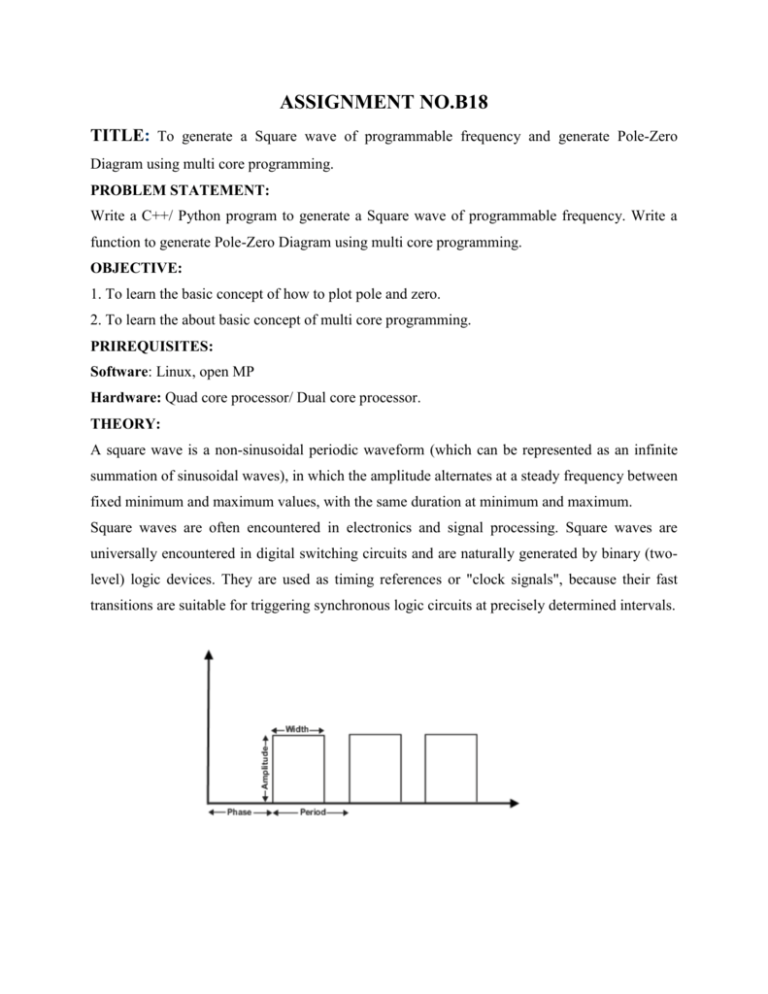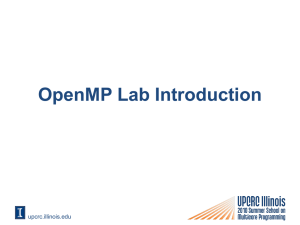coutn Enter `a` :"
advertisement

ASSIGNMENT NO.B18
TITLE: To generate a Square wave of programmable frequency and generate Pole-Zero
Diagram using multi core programming.
PROBLEM STATEMENT:
Write a C++/ Python program to generate a Square wave of programmable frequency. Write a
function to generate Pole-Zero Diagram using multi core programming.
OBJECTIVE:
1. To learn the basic concept of how to plot pole and zero.
2. To learn the about basic concept of multi core programming.
PRIREQUISITES:
Software: Linux, open MP
Hardware: Quad core processor/ Dual core processor.
THEORY:
A square wave is a non-sinusoidal periodic waveform (which can be represented as an infinite
summation of sinusoidal waves), in which the amplitude alternates at a steady frequency between
fixed minimum and maximum values, with the same duration at minimum and maximum.
Square waves are often encountered in electronics and signal processing. Square waves are
universally encountered in digital switching circuits and are naturally generated by binary (twolevel) logic devices. They are used as timing references or "clock signals", because their fast
transitions are suitable for triggering synchronous logic circuits at precisely determined intervals.
If the sampling frequency is '𝑓𝑠 ', then for a wave of amplitude 'a' the number of samples is given
by 2a/𝑓𝑠.
For square wave the only one thing require is the implement counter then switch the sign and
reset the counter every time the half period is passed
𝑦 = (−1)𝑛.𝑇1/2
Where n is the number of half period time 𝑇1/2 that is passed
Algorithm:
Step 1: Enter frequency F and Sampling Frequency Fs.
Step 2:
k=0;
do
{
for(n=(k*Fs)/(2*F);n<((k+1)*Fs)/(2*F);n++)
{ // positive half cycle of square wave
x[n]=A;
if(n>MAX)break;
}
for(n=((k+1)*Fs)/(2*F);n<((k+2)*Fs)/(2*F);n++)
{ // negative half cycle of square wave
x[n] = -A;
if(n>MAX) break;
}
k = k+2; // this count is modified for next cycle
} while(n<MAX);
break;
Step 3: Plotting this wave by using Graphics function.
Draw a pole-zero plot for a given system H(Z) expressed as rational function.
Consider a LTI system with input X(n) and output Y(n).
In terms of z-Transform we can define system transfer function H(z) as the ratio of o/p & i/p
H(Z) = Y(Z)/X(Z)
We can express z-Transform as the ratio of 2 polynomials called as rational z-transform.
X(Z ) = N(Z)/D(Z)
−1
−2
−𝑛
1 𝑧 +𝑏2𝑧 ±⋯……..+𝑏𝑛 𝑧
= 𝑏𝑎0+𝑏
+𝑎 𝑧−1 +𝑏 𝑧−2 +⋯…..+𝑎 𝑧−𝑛
0
1
Poles are the values of Z for which X(Z) is infinity.
Zeros are the values of Z for which X(Z) is 0.
2
𝑛
The equation can be written as,
−𝑘
∑𝑚
𝑘=0 𝑏𝑘 𝑍
𝑋(𝑧) =
𝑎 ∑𝑛𝑘=0 𝑎𝑘 𝑍 −𝑘
Rearranging the equation,
𝑏
𝑏1
⁄𝑏 (𝑍 𝑚−1 ) + ⋯ … … … . . + 𝑚⁄𝑏 ]
0
0
𝑋(𝑍) =
𝑏
𝑍 −𝑛 𝑏0 [𝑍 𝑛 + 1⁄𝑏 (𝑍 𝑛−1 ) + ⋯ … … … . +𝑏𝑛 /𝑏0 ]
0
Where Z1, Z2 ………………. Zm are zeros.
& b1, b2 …………….... bn are poles.
𝑍 −𝑚 𝑏0 [𝑍 𝑚 +
EXAMPLE:
Determine pole-zero plot for the system.
𝑋(𝑍) =
Multiply &divide by Z^2.
1 + 3𝑍 −1
1 + 3𝑍 −1 + 2𝑍 −2
Therefore,
𝑋(𝑍) =
=
𝑍 2 + 3𝑍
𝑍 2 + 3𝑍 + 2
𝑍(𝑍 + 3)
(𝑍 + 1)(𝑍 + 2)
Here, X(Z) is 0 for Z=0 & Z=-3.
X(Z) is ∞ for Z=-1,-2.
Therefore,
Poles = -1,-2.
Zeros = 0,-3.
Algorithm:Step1:
Accept equation from users.
Step2:
Accept second equation from user.
Step3:
Create thread and run on independent core for to calculate poles.
Step4:
Calculate poles.
Step5:
Create other thread and run on other core for to calculate zero.
Step6:
Calculate zeroes.
Step7:
Display pole and zero.
OpenMP
OpenMP (Open Multi-Processing) is an API that supports multi-platform shared memory
multiprocessing programming. OpenMP is an implementation of multithreading, a method of
parallelizing whereby a master thread (a series of instructions executed consecutively) forks a
specified number of slave threads and the system divides a task among them. The threads then
run concurrently, with the runtime environment allocating threads to different processors.
OpenMP uses a portable, scalable model that gives programmers a simple and flexible interface
for developing parallel applications for platforms. An application built with the hybrid model of
parallel programming can run on a computer cluster using both OpenMP and Message Passing
Interface (MPI), or more transparently through the use of OpenMP extensions for non-shared
memory systems. OpenMP is an implementation of multithreading, a method of parallelizing
whereby a master thread (a series of instructions executed consecutively) forks a specified
number of slave threads and the system divides a task among them. The threads then run
concurrently, with the runtime environment allocating threads to different processors.
The section of code that is meant to run in parallel is marked accordingly, with a preprocessor
directive that will cause the threads to form before the section is executed. Each thread has an id
attached to it which can be obtained using a function (called omp_get_thread_num()). The thread
id is an integer, and the master thread has an id of 0. After the execution of the parallelized code,
the threads join back into the master thread, which continues onward to the end of the program.
By default, each thread executes the parallelized section of code independently. Work-sharing
constructs can be used to divide a task among the threads so that each thread executes its
allocated part of the code. Both task parallelism and data parallelism can be achieved using
OpenMP in this way.
The runtime environment allocates threads to processors depending on usage, machine load and
other factors. The runtime environment can assign the number of threads based on environment
variables, or the code can do so using functions.
Thread Based Parallelism:
1.
OpenMP programs accomplish parallelism exclusively through the use of threads.
2.
A thread of execution is the smallest unit of processing that can be scheduled by an
operating system. The idea of a subroutine that can be scheduled to run autonomously
might help explain what a thread is.
3.
Threads exist within the resources of a single process. Without the process, they cease to
exist.
4.
Typically, the number of threads matches the number of machine processors/cores.
However, the actual use of threads is up to the application.
Explicit Parallelism:
1.
OpenMP is an explicit (not automatic) programming model, offering the programmer full
control over parallelization.
2.
Parallelization can be as simple as taking a serial program and inserting compiler
directives.
3.
Or as complex as inserting subroutines to set multiple levels of parallelism, locks and
even nested locks.
Threads:-The number of threads in a parallel region is determined by the following factors, in
order of precedence:
1. Evaluation of the IF clause
2. Setting of the NUM_THREADS clause
3. Use of the omp_set_num_threads() library function
4. Setting of the OMP_NUM_THREADS environment variable
5. Implementation default - usually the number of CPUs on a node, though it could
be dynamic (see next bullet).
Threads are numbered from 0 (master thread) to N-1
Dynamic Threads:
Use the omp_get_dynamic() library function to determine if dynamic threads are
enabled.
If supported, the two methods available for enabling dynamic threads are:
1. The omp_set_dynamic() library routine
2. Setting of the OMP_DYNAMIC environment variable to TRUE
Conclusion: - In this way we generate a Square wave of programmable frequency and calculate
Pole-Zero using multi core programming.
#include<iostream>
#include<omp.h>
#include<math.h>
//#include<libgraph.h>
using namespace std;
int neg1=0,neg2=0,a=-1,b=-1;
int main(){
float A1,B1,C1;
float A2,B2,C2;
double pole1,zero1,pole2,zero2;
cout<<"\n Enter First Equation :";
cout<<"\n Enter 'a' :";
cin>>A1;
cout<<"\n Enter 'b' :";
cin>>B1;
cout<<"\n Enter 'c' :";
cin>>C1;
cout<<"\n Enter Second Equation :";
cout<<"\n Enter 'a' :";
cin>>A2;
cout<<"\n Enter 'b' :";
cin>>B2;
cout<<"\n Enter 'c' :";
cin>>C2;
float temp1,temp2,numerator1,numerator2;
#pragma omp parallel
{
int threads= omp_get_num_threads();
// Zero calculation
if(omp_get_thread_num()==0 && a<0)
{
a++;
cout<<"\n Thread A is Caculating Zero. (TID: "<<omp_get_thread_num()<<" )";
temp1=(B1*B1)-(4*A1*C1);
if(temp1<0)
{
neg1=1;
temp1=-temp1;
}
temp1=sqrt(temp1);
numerator1=temp1;
if(!neg1){
zero1=(-B1+ numerator1)/2*A1;
zero2=(-B1- numerator1)/2*A1;
}
else
{
temp1=2*A1;
}
}
// Pole calculation
if(omp_get_thread_num()==1 && b<0)
{
b++;
cout<<"\n Thread B is Caculating Pole. (TID: "<<omp_get_thread_num()<<" )";
temp2=(B2*B2)-(4*A2*C2);
if(temp2<0)
{
neg2=1;
temp2=-temp2;
}
temp2=sqrt(temp2);
numerator2=temp2;
if(!neg2){
pole1=(-B2+ numerator2)/2*A2;
pole2=(-B2- numerator2)/2*A2;
}
else
{
temp2=2*A2;
}
}
}
if(!neg1){
cout<<"\n Zero 1 is :"<<zero1;
cout<<"\n Zero 2 is :"<<zero2;
}
else{
cout<<"\n Zero 1 is : "<<-B1/temp1<<" +i "<<numerator1/temp1;
cout<<"\n Zero 2 is : "<<-B1/temp1<<" -i "<<numerator1/temp1<<endl;
}
if(!neg2){
cout<<"\n Pole 1 is :"<<pole1;
cout<<"\n Pole 2 is :"<<pole2<<endl;
}
else
{
cout<<"\n Pole 1 is : "<<-B2/temp2<<" +i "<<numerator2/temp2;
cout<<"\n Pole 2 is : "<<-B2/temp2<<" -i "<<numerator2/temp2<<endl;
}
return 0;
}
g++ -fopenmp pz.cpp -o pz
./pz
#include<stdio.h>
#include<conio.h>
#include<math.h>
#include<stdlib.h>
#include<graphics.h>
#define MAX 500
#define A 1.0
void main()
{
float x[700],F,Fs,n,Y;
int gd,gm,X,option,k;
char ch,ch1;
clrscr();
l1:
do
{
clrscr();
printf("Generation of discrete time signals \n");
printf("\nEnter the frequency of analog signal F = ");
scanf("%f",&F);
//frequency of the signal
printf("Enter the sampling frequency Fs = ");
scanf("%f",&Fs);
//sampling frequency
printf("\nEnter your choice");
printf("\nsine wave (Enter 1)");
//sine wave
printf("\nsquare wave (Enter 2)");
//square wave
printf("\n Exit (Enter 3)");
scanf("%d",&option);
// i = 640;
//640 samples of the signal will be generated
// A = 1.0;
//maximum amplitude of the signals is 1
switch(option)
{
case 1 : for(n = 0; n < MAX; n++) // sine wave
x[n] =A*sin(2*M_PI*F*(n/Fs));
break;
case 2 :
k=0;
// square wave
do
{
for(n=(k*Fs)/(2*F);n<((k+1)*Fs)/(2*F);n++)
{
// positive half cycle of aquare wave
x[n]=A;
if(n>MAX)break;
}
for(n=((k+1)*Fs)/(2*F);n<((k+2)*Fs)/(2*F);n++)
{ // negative half cycle of aquare wave
x[n] = -A;
if(n>MAX) break;
}
k = k+2; // this count is modified for next cycle
} while(n<MAX);
break;
case 3:exit(0);
break;
deault:printf("\n oops .. wrong option");
}
//----- next part of the program displays the generated Signal
Y = X = 0;
gd =gm= DETECT;
// initialize screen in graphics mode
initgraph(&gd,&gm,"c:\\tc\\bgi");
outtextxy(130,20,"Standard signals");
line(1,50,1,350);
line(1,200,550,200);
for(n = 0; n < MAX; n++)
{
// this loop displays 640 samples of discrete time signal
Y = 200 - x[n]*100; //scaling of x(n) for proper display
putpixel(X,Y,WHITE); //x(n) is displayed as putting pixels
X++;
}
getch();
closegraph();
fflush(stdin);
printf("\n \n do u want to continue...");
printf("\n press y if yes, otherwise press any other key..");
scanf("%c",&ch);
}
while(ch=='y');
}





